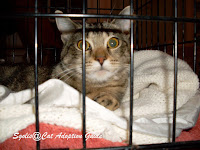Breakaway cat collars are designed so when the collar has
pressure the buckle will open and the cat will be released from the
collar. Breakaway collars are essential
for all outdoor cats. It protects the cat from getting hung up on a branch or fence post.
There are many types of breakaway cat collars, some are plain with bell and identification tag and others are reflective which allows motorist to see the cat on the street and the pet owner to view the cat in their yard or in a dark room.
There are many types of breakaway cat collars, some are plain with bell and identification tag and others are reflective which allows motorist to see the cat on the street and the pet owner to view the cat in their yard or in a dark room.
Both indoor-outdoor cats need breakaway
collars with an identification tag.
These collars are helpful especially if the cat wanders off and gets
lost.
Example: A few years back there was a tornado and all of our cats got outside from a broken window. Luckily they all had their collars on and identification tags and all were returned to us.
Example: A few years back there was a tornado and all of our cats got outside from a broken window. Luckily they all had their collars on and identification tags and all were returned to us.
When it comes to cat safety I usually buy breakaway collars in bulk. I look for them when they are on sale and buy as many as I can. All cats that go outdoors wear a breakaway collar that has their identification tag.
Cat Collar - Size and Fit
Make sure the breakaway cat collar is the right size. Measure your cats neck and then buy a collar that is one inch larger. If your cats neck is 8 inches get a 9 inch collar.
You can adjust the collar to fit your cat's neck. Proper fit is important. I do not put the collar on tight; a collar that allows two fingers to fit in-between your cat’s neck and the collar is a good fit. Also make sure that the collar will move freely from side to side on your cat’s neck.
Cat Collar - Size and Fit
Make sure the breakaway cat collar is the right size. Measure your cats neck and then buy a collar that is one inch larger. If your cats neck is 8 inches get a 9 inch collar.
You can adjust the collar to fit your cat's neck. Proper fit is important. I do not put the collar on tight; a collar that allows two fingers to fit in-between your cat’s neck and the collar is a good fit. Also make sure that the collar will move freely from side to side on your cat’s neck.
Cat Collar Safety Tips:
- Allow the cat to get use to the collar by putting the collar on the cat while they are in the house. Once the cat is use to the collar they will not try to get it off.
- Get a Reflective
Safe Cat collar
that is visible up to 600 feet.
- Thin safety collars are good for cats that are not use to collars. Allow the cat to get use to safety collar before going outdoors. Make sure it is a good fit and that the cat will not be able to get paw up under the collar.
- Collars with bells are good especially for birds, they will know when your outdoor cat is close. Bells will also give you an idea as to where your cat is.
- Okay to buy small dog breakaway collar (toy breed) for your cat.
Breakaway Collar Warnings:
- Never glue the buckle on a cat collar shut.
- Check collars with bells to make sure the bell is attached securely. If it is loose it is better to remove the bell as your cat may swallow it.







